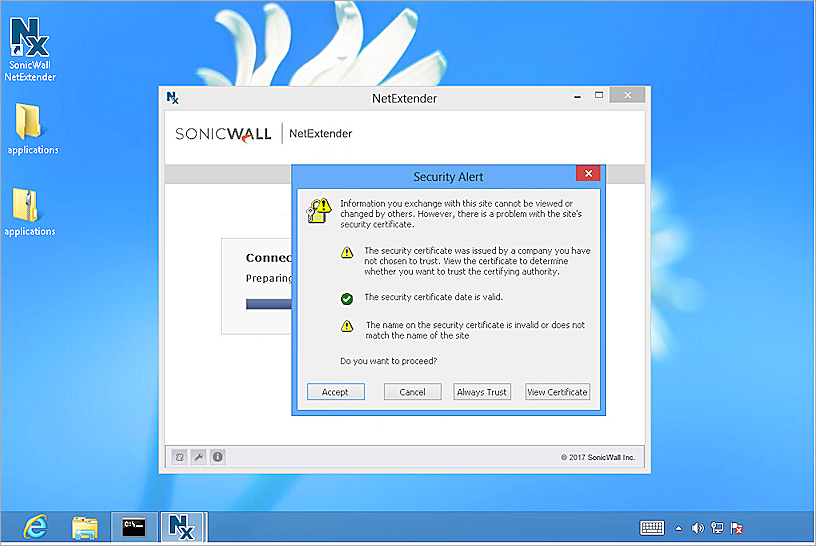Deployment Overview
This document describes how to set up multi-factor authentication (MFA) for Dell SonicWall Network Security Appliance with AuthPoint as an identity provider.
Your SonicWall Network Security Appliance must already be configured and deployed before you set up MFA with AuthPoint. Your SonicWall Network Security Appliance can be configured to support MFA in several modes. For this integration, we set up RADIUS authentication with AuthPoint.
This integration was tested with SonicOS Enhanced 6.2.7.1-23n of SonicWall Network Security Appliance TZ 400.
SonicWall Network Security Appliance Authentication Data Flow with AuthPoint
AuthPoint communicates with various cloud-based services and service providers with the RADIUS protocol. This diagram shows the data flow of an MFA transaction for a SonicWall Network Security Appliance.

Before You Begin
Before you begin these procedures, make sure that:
- You have installed and configured the AuthPoint Gateway (see About Gateways)
- End-users can log in to the SonicWall Network Security Appliance
- A token is assigned to a user in AuthPoint
Configure SonicWall Network Security Appliance
Configure a RADIUS Server
To use the RADIUS authentication with SonicWall Network Security Appliance, a RADIUS server (the AuthPoint Gateway) must be configured in the users configuration.
- Log in to the SonicWall Network Security Appliance web UI.
- Select Users > Settings.
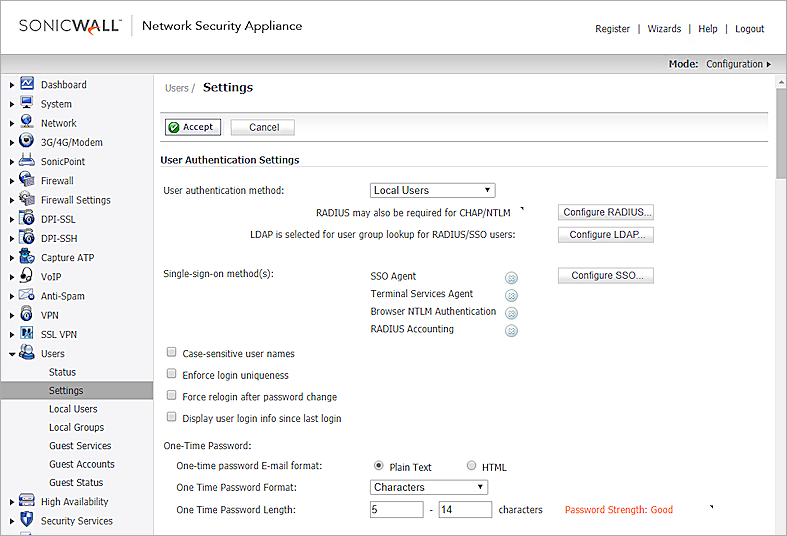
- Click Configure RADIUS.
- In the RADIUS Server Timeout(seconds) text box, type 60.
- From the User Name Format drop-down list, select Simple-Name.
- In the Primary Server section, in the Name or IP Address text box, type the IP address of your RADIUS server (the AuthPoint Gateway).
- In the Primary Server section, in the Shared Secret text box, type a shared secret to identify your RADIUS client.
- In the Primary Server section, in the Port Number text box, type the port for the RADIUS server (AuthPoint Gateway) to use to communicate with the RADIUS client (SonicWall Network Security Appliance). The default ports are 1812 and 1645.
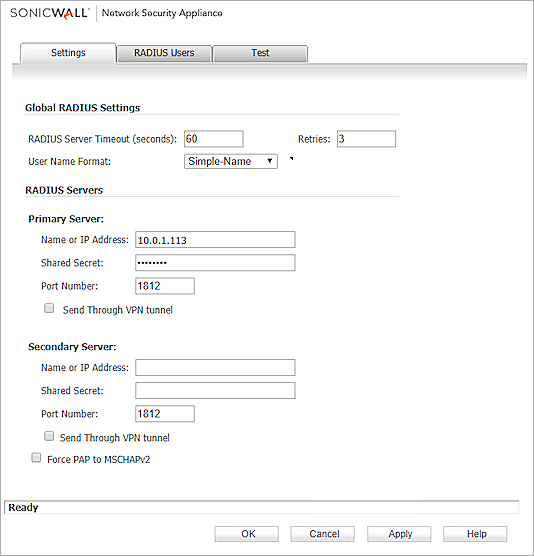
- Select the RADIUS Users tab.
- Select Use RADIUS Filter-Id attribute on RADIUS server.
- From the Default user group drop-down list, select SSLVPN Services.
- Click OK.
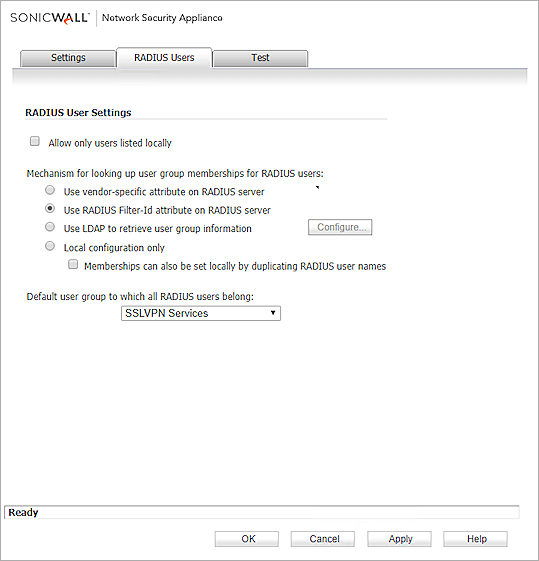
Configure User Authentication Settings
Next, you must enable RADIUS user authentication in user authentication settings.
- Select Users > Settings.
- From the User authentication method drop-down list, select RADIUS.
- Click Accept.
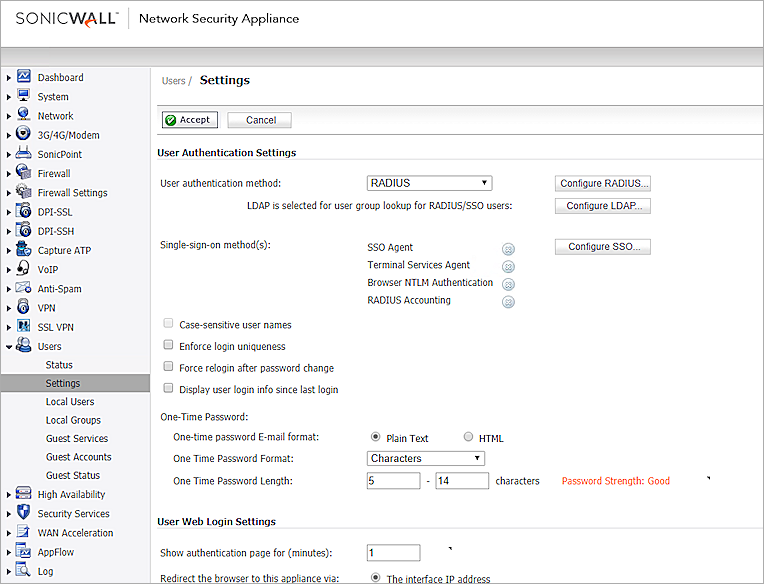
Configure SSL VPN Server Settings
- Select SSL VPN > Server Settings.
- For SSL VPN Status on Zones, select WAN.
- In the SSL VPN Port text box, type the port to use.
- In the User Domain text box, type your domain.
- Click Accept.
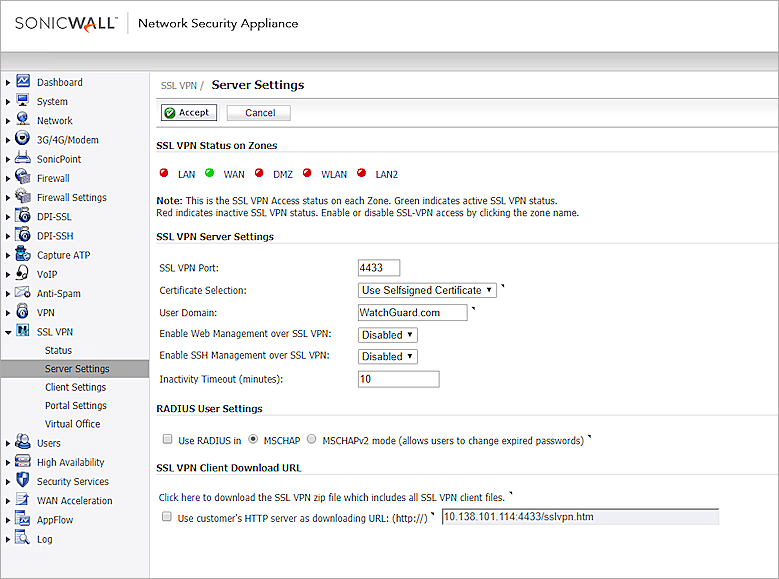
Configure SSL VPN Client Settings
- Select SSL VPN > Client Settings.
- In the Default Device Profile list, click Configure.
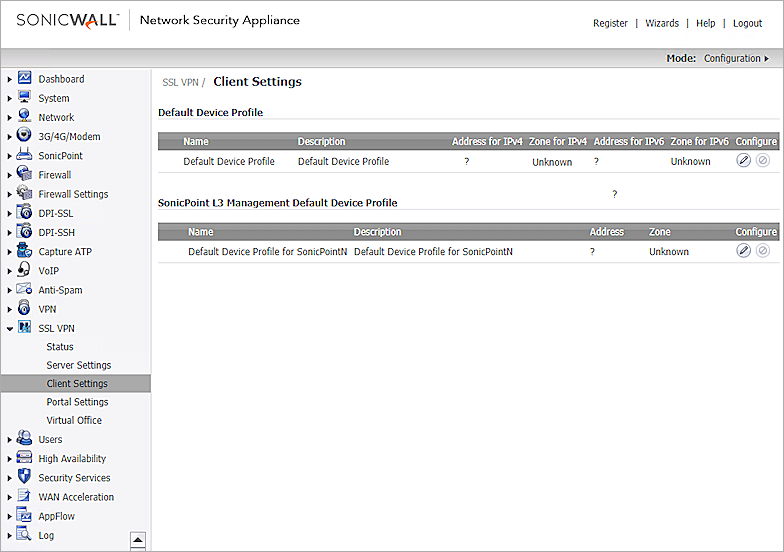
- From the Network Address IPV4 drop-down list, select Create a new network.
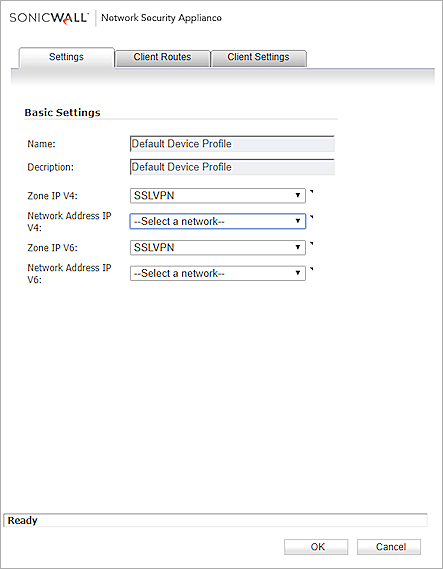
- In the Name text box, type a descriptive network name.
- From the Type drop-down list, select Network.
- In the Network text box, type an IP address.
- In the Netmask/Prefix Length text box, type a network mask value.
- Click OK.
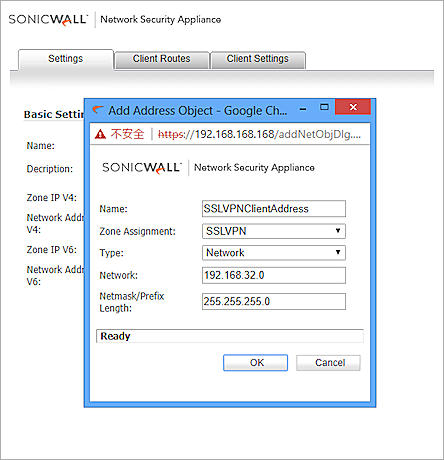
- In the Network Address IPV4 drop-down list, select the network item you created.
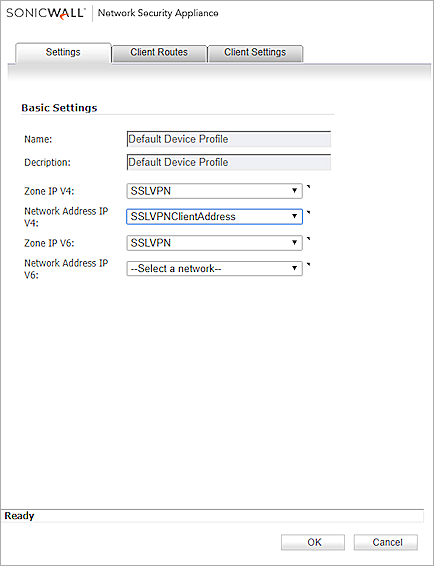
- Select the Client Routes tab.
- From the Networks list, select one or more networks and add them to the Client Routes list.
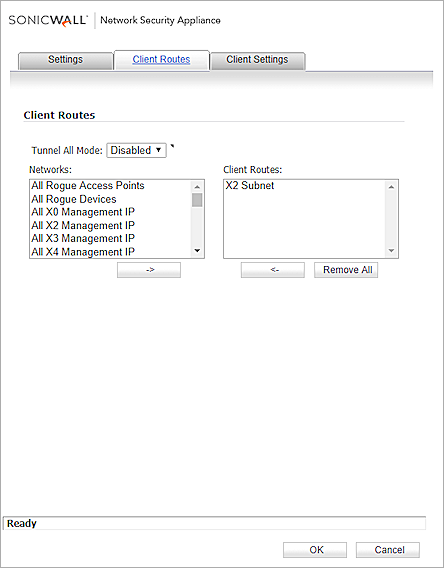
- Select the Client Settings tab.
- Configure your client settings. Click OK.
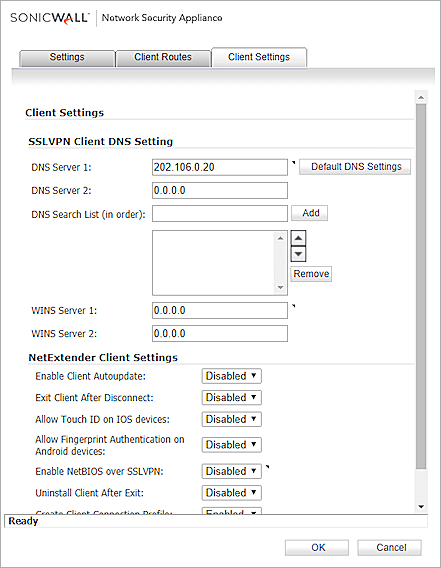
Configure AuthPoint
Before AuthPoint can receive authentication requests from SonicWall, you must add SonicWall as a RADIUS client resource in AuthPoint. You must also create an authentication policy for the SonicWall RADIUS client resource and you must bind the SonicWall RADIUS client resource to the AuthPoint Gateway.
Add a Radius Resource in AuthPoint
From the AuthPoint management UI:
- From the navigation menu, select Resources.
Click Add Resource.
The Add Resource page opens.

- From the Type drop-down list, select RADIUS Client.
Additional fields appear.

- In the Host text box, type the IP address for your SonicWall Network Security Appliance.
- In the User ID drop-down list, select User Name.
- In the Shared Secret text box, type the shared secret for your SonicWall Network Security Appliance.
- Click Save.
Add a Group in AuthPoint
You must have at least one user group in AuthPoint to configure MFA. If you already have a group, you do not have to add another group.
To add a group to AuthPoint:
- From the navigation menu, select Groups.
- Click Add Group.
The New Group page appears.

- In the Name text box, type a descriptive name for the group.
- (Optional) In the Description text box, type a description of the group.
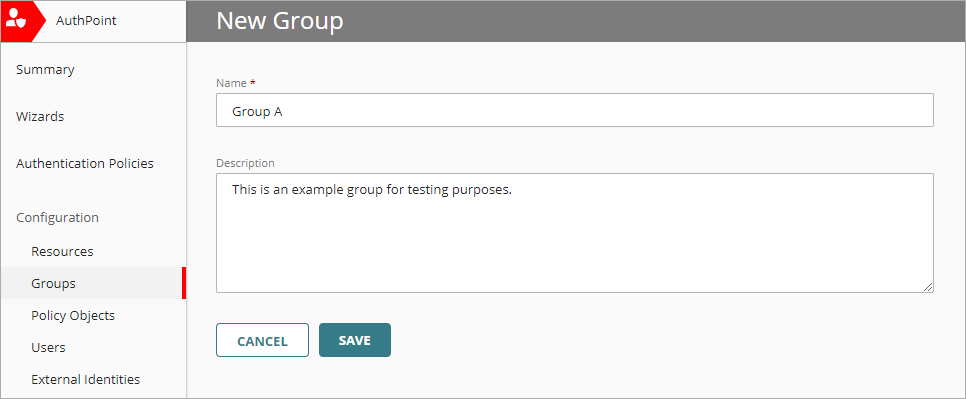
- Click Save.
Your group is listed on the Groups page.
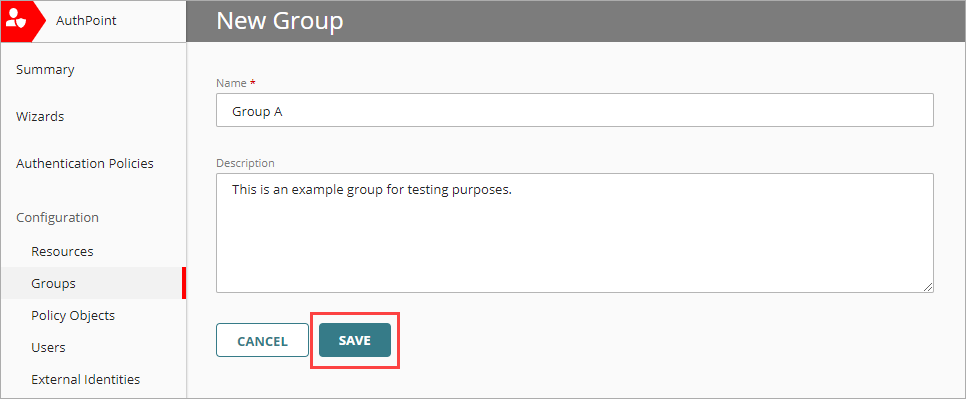
Add an Authentication Policy to AuthPoint
Authentication policies specify which resources users can authenticate to and which authentication methods they can use (Push, QR code, and OTP).
You must have at least one authentication policy in AuthPoint that includes the SonicWall RADIUS client resource. If you already have authentication policies, you do not have to create a new authentication policy. You can add this resource to your existing authentication policies.
Users that do not have an authentication policy for a specific resource cannot authenticate to log in to that resource.
To configure an authentication policy:
- From the navigation menu, select Authentication Policies.
The Authentication Policies page opens.

- Click Add Policy.
The Add Policy page opens.
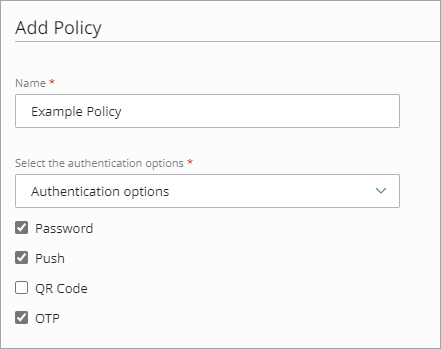
- In the Name text box, type a name for this policy.
- From the Select the Authentication Options drop-down list, select Authentication Options, then select which authentication options users can choose from when they authenticate.
If you enable the push and OTP authentication methods for a policy, RADIUS client resources associated with that policy use push notifications to authenticate users.
QR code authentication is not supported for RADIUS client resources.
- From the Groups drop-down list, select which groups this policy applies to. You can select more than one group. To configure this policy to apply to all groups, select All Groups.
- From the Resources drop-down list, select the resource that you created in the previous section. If you want this policy to apply to additional resources, select each resource this policy applies to. To configure this policy to apply to all resources, select All Resources.
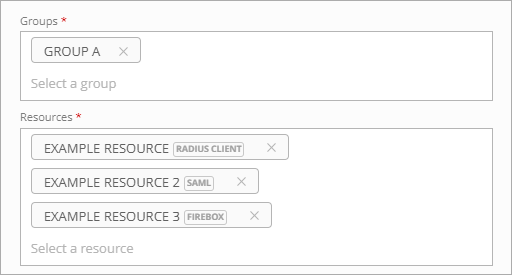
-
(Optional) If you have configured policy objects such as a Network Location, select which policy objects apply to this policy. When you add a policy object to a policy, the policy only applies to user authentications that match the conditions of the policy objects. For example, if you add a Network Location to a policy, the policy only applies to user authentications that come from that Network Location. Users who only have a policy that includes a Network Location do not get access to the resource when they authenticate outside of that Network Location (because they do not have a policy that applies, not because authentication is denied).
For RADIUS authentication, policies that have a Network Location do not apply because AuthPoint does not have the IP address of the user.
If you configure policy objects, we recommend that you create a second policy for the same groups and resources without the policy objects. The policy with the policy objects should have a higher priority.

- Click Save.
Your policy is created and added to the end of the policy list.When you create a new policy, we recommend that you review the order of your policies. AuthPoint always adds new policies to the end of the policy list.
Bind the RADIUS Resource to a Gateway
To use RADIUS authentication with AuthPoint, you must have the AuthPoint Gateway installed on your corporate network and you must assign your RADIUS resources to the Gateway in the AuthPoint web UI. The Gateway functions as a RADIUS server.
If you have not configured and installed the AuthPoint Gateway, see About Gateways.
- From the navigation menu, select Gateway.
- Select the Name of the Gateway.
-
From the RADIUS section, in the Port text box, type the port number used to communicate with the Gateway. The default ports are 1812 and 1645.
If you already have a RADIUS server installed that uses port 1812 or 1645, you must use a different port for the AuthPoint Gateway.
- From the Select a RADIUS Resource drop-down list, select your RADIUS client resource.
- Click Save.
Add Users to AuthPoint
Before you assign users to a group, you must add the users to AuthPoint. There are two ways to add AuthPoint user accounts:
- Sync users from an external user database
- Add local AuthPoint users
Each user must be a member of a group. You must add at least one group before you can add users to AuthPoint.
To import users from Active Directory, Microsoft Entra ID, or an LDAP database, you must add an external identity in the AuthPoint management UI. External identities connect to user databases to get user account information and validate passwords.
- To sync users from Active Directory or an LDAP database, you must add an LDAP external identity
- To sync users from Microsoft Entra ID, you must add a Microsoft Entra ID external identity
When you sync users from an external user database, you can sync any number of users and they are all added to AuthPoint at one time. Users synced from an external user database use the password defined for their user account as their AuthPoint password.
To learn how to sync users, go to Sync Users from Active Directory or LDAP and Sync Users from Azure Active Directory.
You can create local AuthPoint users on the Users page in the AuthPoint management UI. Because you can create only one user at a time, you most commonly do this when you want to create test users or to add only a small number of users.
Unlike users synced from an external user database, local AuthPoint users define and manage their own AuthPoint password. When you add a local user account, the user receives an email that prompts them to set their password.
To learn how to add local AuthPoint user accounts, go to Add Local AuthPoint Users.
Test the Integration
To test the integration of AuthPoint and configuration of your SonicWall Network Security Appliance, you can authenticate with a mobile token on your mobile device. For RADIUS resources, you can choose one-time password (OTP) or push.
In this example, we show the one-time password authentication method.
- Run the SonicWall NetExtender client application.
- In the Server text box, type the SonicWall Network Security Appliance WAN Interface IP address and SSL VPN port.
- In the Username text box, type AuthPoint user name.
- In the Password text box, type your AuthPoint password and OTP. The OTP for your token is shown in the AuthPoint mobile app.
- In the Domain text box, type the domain for your remote SSL VPN connection.
- Click Connect.

- In the Security Alert dialog, click Accept.
